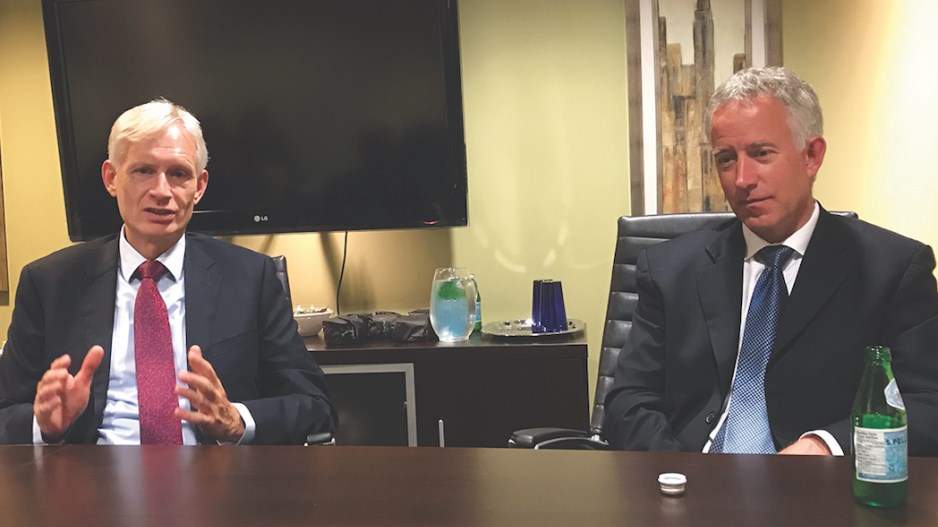The federal government is shipping $42 billion worth of steel work to China at the expense of Canadian workers and steelmakers, says a major industry association.
The Canadian Institute of Steel Construction recently slammed the government of Justin Trudeau for waiving tariffs on foreign steel imports for the LNG Canada ($40 billion) and Woodfibre LNG ($1.4 billion to $1.8 billion) projects.
The CEOs of Shell Canada and Petronas Canada — the two major partners in the LNG Canada project — say the claim that the remission of steel tariffs for liquefied natural gas (LNG) projects will result in $42 billion of offshoring is simply not true.
While the LNG modules — also known as liquefaction trains — for the LNG Canada plant in Kitimat will be built in Asian steel yards, that only accounts for a portion of the $17 billion capital cost of the LNG plant in Kitimat, although LNG Canada won’t disclose just how much will be spent overseas.
According to an analysis by Canadian engineer Reza Naghash, the liquefaction trains for an LNG plant account for 50 per cent of total plant costs.
“The majority of what the overall cost is will be spent in Canada,” said Susannah Pierce, director of corporate affairs for LNG Canada.
The $40 billion price tag for LNG Canada includes the $6.2 billion Coastal GasLink pipeline, which will be built in Canada, mostly with Canadian steel.
Billions more will be spent in B.C. over the next 40 years in the upstream development, as new natural gas wells, processing plants and gathering systems are built to meet the demand for gas over the life of the LNG plant.
Already, about 2,500 people are employed on the project, according to Shell Canada CEO Michael Crothers — in Kitimat, along the Coastal GasLink pipeline route and at the Calgary office of Fluor Corp., part of joint venture JGC Fluor, which has the engineering, procurement and construction contract for the project.
“In Calgary there is a big office of Fluor — about 500 engineers working on the project,” Crothers said.
Crothers said all the foundations, which include a lot of rebar, will be built using Canadian workers and suppliers. And most of the steel for the Coastal GasLink pipeline will be provided by Evraz steel plants in Canada, he said.
Canadian LNG projects are not the only ones to have LNG modules built in Asia. Projects in Australia also had LNG trains built in Asia.
Crothers and Mark Fitzgerald, CEO for Petronas Canada, said Canadian steel plants simply don’t have the capacity to build LNG modules on the scale required for a project like LNG Canada.
“I don’t think there’s a yard big enough in Canada to build them,” said Fitzgerald.
The LNG trains are the size of a 10-storey hotel, Crothers said.
“We can’t be competitive as an LNG export nation unless we have access to the most effective assembly line for these massive modules. That kind of expertise to build modules of that scale doesn’t exist in Canada. But what we do have in Canada is the ability to put them all together.”
Ed Whalen, CEO for the Canadian Institute of Steel Construction, said his association’s biggest beef with the Trudeau government’s remission of steel tariffs is that Canadian steel fabricators didn’t even have the chance to bid on the LNG Canada and Woodfibre LNG projects.
“We don’t have a problem with offshoring to a country that is competing fairly with us,” Whalen said. “And if we’re not low enough to get the price, so be it.
“The problem with China, we’ve caught them at illegally dumping and subsidizing their fabricated steel into Canada, and as a result we won’t even have a chance to bid on these particular two (projects).”
David Keane, president of Woodfibre LNG, said the Canadian steel industry has known for years that an LNG industry was being developed in Canada, but made none of the investments needed to build the capacity it would need to develop the massive assembly yards that would be needed. And maybe that’s because such an investment would not make sense for just one or two LNG projects.
“You’re not going to build a multibillion-dollar module yard for just one or two LNG plants,” Keane said.
It’s not just the LNG plant and pipeline that will employ Canadians during peak construction. LNG Canada has a 40-year export licence, which means it will need a lot of natural gas over the next four decades.
“The planning horizon for Petronas for LNG Canada is 40-plus years, and delivering our share of natural gas to that facility over 40 years is going to require an investment of somewhere between $1 billion to $2 billion per year in the upstream, depending on the year,” Fitzgerald said.
“That investment will flow to local communities, local business, the development of Indigenous business, the development of local skills.”
Petronas is already starting to ramp up its natural gas production. It has two drilling rigs running in northeastern B.C.
As for Shell Canada, it plans to start ramping up its natural gas production in late 2020. That will include an expansion to its Saturn natural gas plant, which will be fully electric.
— Nelson Bennett, Business In Vancouver



